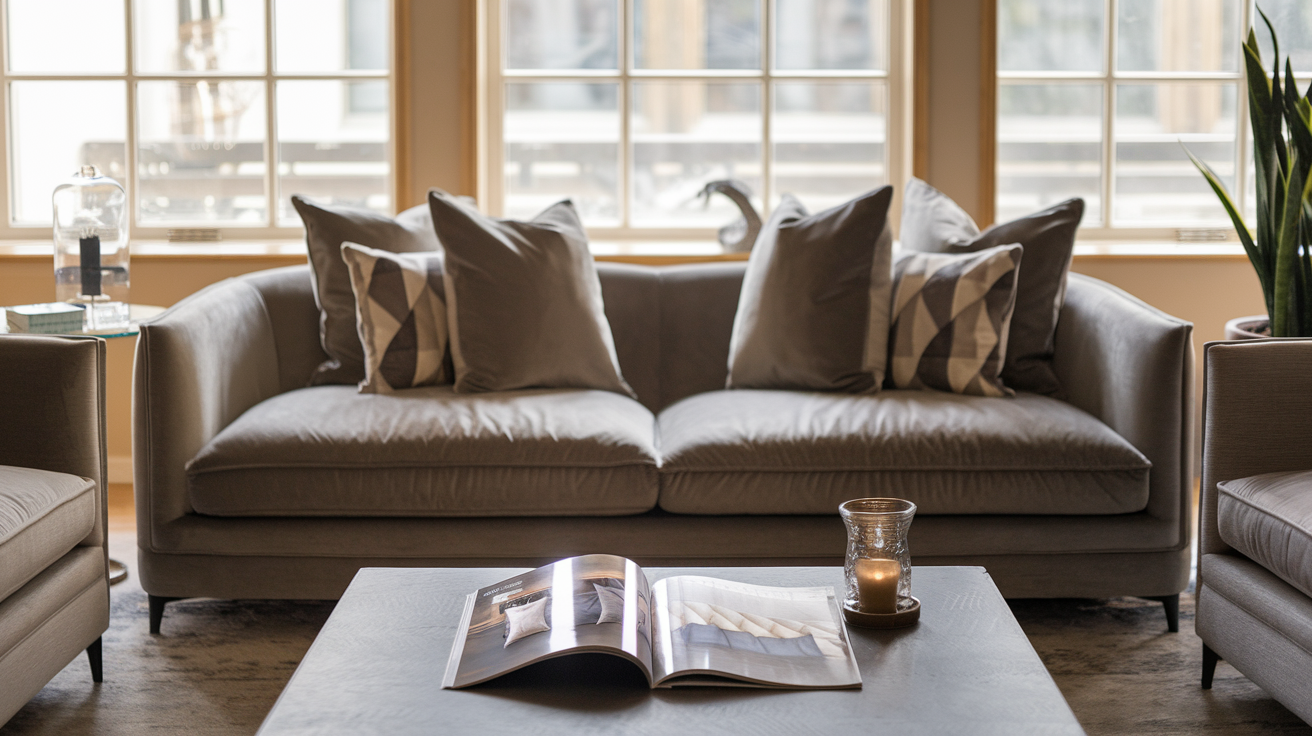The Ultimate Guide to Choosing the Perfect Sofa: Style, Comfort
Learn how to choose the perfect sofa with ‘The Ultimate Guide to Choosing the Perfect Sofa.’ From quality to comfort, we’ve got you covered!
Have you ever spent hours sitting on an uncomfortable sofa, wondering how you made such a costly mistake? Or perhaps you’ve fallen in love with a beautiful piece only to discover it won’t fit through your doorway? Finding the perfect sofa is more complex than most people realize – it’s an investment that impacts your comfort, home aesthetic, and daily living experience for years to come.
The average person spends thousands of dollars on a quality sofa and uses it for 7-15 years. Yet many rush this crucial decision, leading to buyer’s remorse and wasted money. From frame construction that determines longevity to cushion types that affect comfort, and from upholstery materials that suit your lifestyle to dimensions that work in your space – every detail matters. 💡
In this comprehensive guide, we’ll walk you through everything you need to know before making this significant purchase. We’ll explore proper measurements and space planning, budgeting strategies, construction quality indicators, upholstery options, comfort factors, style considerations, and essential maintenance tips to ensure your sofa remains beautiful and functional for years to come.
Understanding Sofa Dimensions and Space Planning
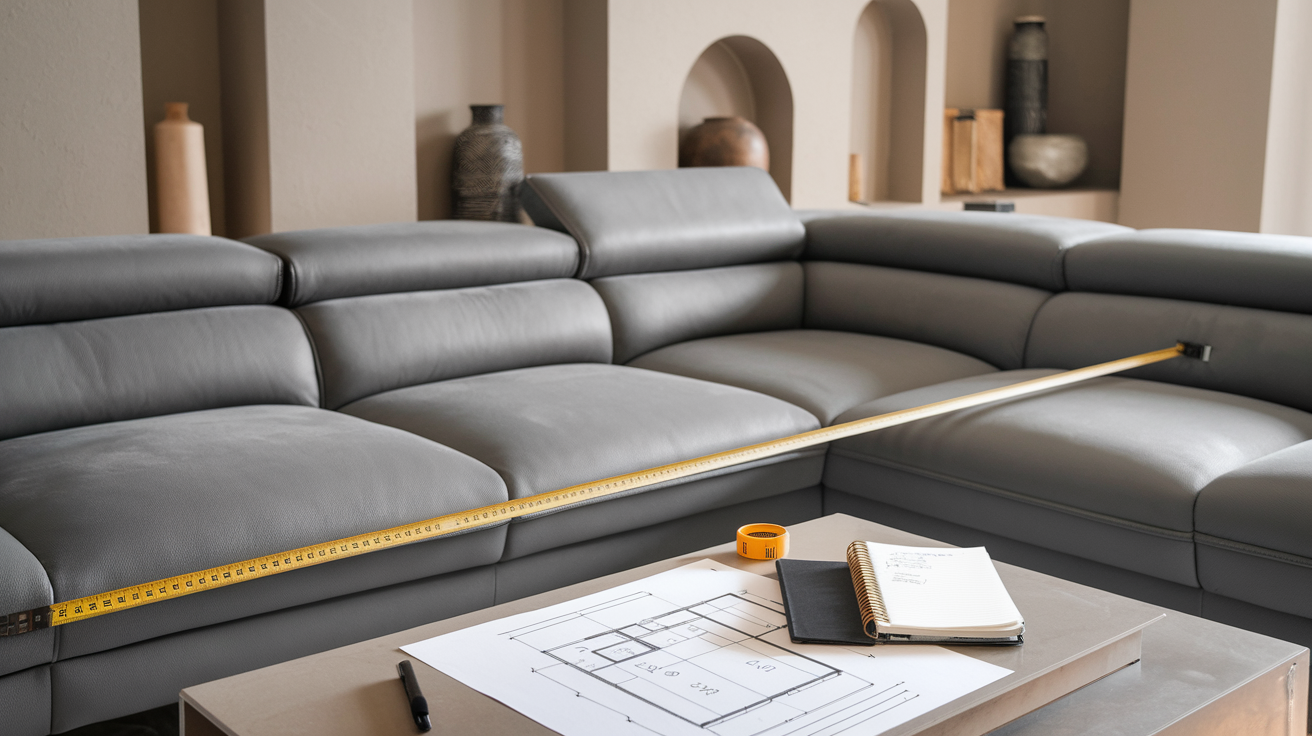
Understanding Sofa Dimensions and Space Planning
When choosing the perfect sofa, understanding dimensions and proper space planning is crucial to ensure your new furniture fits comfortably in your living space. The right measurements can make the difference between a harmonious room layout and an awkward, cramped environment.
Measure Twice, Buy Once: Ensuring Proper Fit
Standard sofas come in various dimensions that you should be familiar with before making a purchase:
- Width: Standard three-seater sofas typically range from 71″ to 86″ (or approximately 177cm to 243cm)
- Depth: Average sofa depths are around 38 inches, with seat depths ranging from 21 to 24 inches for standard models
- Seat Height: Generally varies from 15 to 20 inches, which affects both comfort and compatibility with coffee tables
- Back Height: This dimension significantly influences user experience based on personal preferences and body types
For smaller spaces, consider loveseats which average around 65 inches (or 52″ to 66″) in width, making them ideal for compact areas or as additional seating arrangements.
To ensure a proper fit, follow these essential steps:
- Consider the intended placement location, allowing for 30″ of walking room in front of the sofa
-
Use tape on your floor to outline the intended area and help you visualize the space.
- Measure the taped dimensions accurately
- Compare these measurements with the sofa specifications you’re considering
- Factor in comfort-related measurements like seat height and depth based on household members’ stature
Choosing the Right Size for Your Space
The size of your sofa should be proportionate to your room dimensions to avoid overwhelming the space. When selecting the appropriate size:
- For smaller living rooms, consider two-seater sofas like the Model 1 (175cm wide, 82cm high, and 85cm deep)
- For medium spaces, three-seater options like the Model 02 (205cm wide) provide ample seating while maintaining a reasonable footprint
- For larger areas, L-shaped or sectional sofas can work well, with typical corner seat dimensions around 92cm wide and deep
Maintain proper spacing around your sofa:
- Allow 12″ to 18″ between the sofa and coffee table
- Ensure a minimum of 30 inches of walking space in areas with high foot traffic
- Consider the relationship with other furniture pieces like armchairs (ranging from 55x65cm to 90x85cm)
For visual confirmation, use masking tape to outline the sofa’s footprint in your room before purchasing. This simple step can prevent costly mistakes and help you visualize how the furniture will fit your overall design scheme.
Accounting for Doorways and Movement Paths
Even the perfect sofa for your room won’t work if you can’t get it through your door. Before finalizing your purchase:
- Measure all doorways the sofa must pass through during delivery
- Check hallway widths and any tight corners the furniture must navigate
- If you live in an apartment building, measure elevator dimensions or stairwell clearances
- Consider ceiling heights in stairwells for tall sofas
For complex layouts or tight spaces, consider:
- Sofas with removable legs that reduce overall height during delivery
- Modular or sectional designs that can be brought in piece by piece
- Flat-pack options like Swyft sofas that arrive disassembled and can be put together in about five minutes
Remember to clear the delivery path before your furniture arrives, removing any obstacles that might impede the movers’ progress or potentially damage your new sofa.
Now that we’ve covered the essential aspects of sofa dimensions and space planning, we’ll explore another crucial consideration in your sofa-buying journey: budgeting for quality and value. Understanding how to balance cost with durability and features will help ensure your investment delivers long-term satisfaction.
Budgeting for Quality and Value

Budgeting for Quality and Value
Now that we’ve covered how to properly measure your space and determine the right sofa dimensions for your living area, it’s equally important to understand how to budget appropriately for this significant furniture investment. While finding the perfect size sofa is crucial, balancing cost with quality will ensure your purchase provides lasting value and satisfaction.
Balancing Cost with Longevity
When shopping for a sofa, prices can range dramatically from $300 to over $10,000, making it essential to understand what you’re getting at different price points. For budget-conscious buyers, quality sofas typically start in the $1,000 to $1,500 range, offering a reasonable balance between affordability and durability. Mid-range options from $1,500 to $4,000 provide a wider selection of styles and materials, while high-end sofas priced above $4,000 generally feature superior construction and materials.
Rather than focusing solely on the initial cost, consider the lifespan of your purchase. A well-made sofa should last between 7 to 15 years, making a slightly higher upfront investment more economical over time. For instance, spending $2,000 on a sofa that lasts 10 years costs you $200 per year—often better value than replacing a $700 sofa every 3-4 years due to quality issues.
According to furniture experts, a good rule of thumb is to allocate approximately 20-30% of your total furniture budget for your sofa. This approach helps balance your overall home furnishing expenses while recognizing the sofa’s importance as a central piece in your living space.
Where to Invest vs. Where to Save
Making smart decisions about where to spend and where to economize can help you maximize value without sacrificing quality:
Worth the Investment:
- Frame Construction: Solid hardwood frames significantly improve durability and longevity
- Cushion Quality: High-resilient foam or down-wrapped cushions maintain comfort longer
- Upholstery Materials: Performance fabrics or quality leather for homes with children or pets
Areas to Save:
- Shopping Timing: Purchase during major sales periods like Labor Day, Memorial Day, or January through April when retailers clear inventory
- Simpler Designs: Fewer special features or customizations can reduce cost while maintaining structural integrity
- Floor Models: Display pieces often come with substantial discounts while offering the same quality
For example, the IKEA Kivik Sofa represents a budget-friendly option around $700, while the BenchMade Modern Eva Sofa with its lifetime guarantee commands a premium price but offers exceptional customization and durability. The Article Ceni 83″ Sofa at a mid-range price point delivers mid-century aesthetics at a more affordable rate compared to high-end alternatives.
Understanding Warranty Coverage
A sofa’s warranty can be a significant indicator of its expected quality and longevity. Most reputable manufacturers offer warranties ranging from 1 to 10 years, with a minimum of 5 years generally suggesting confidence in the product’s durability. When evaluating warranty options:
- Look for coverage of the frame, which should ideally be warranted for the longest period
- Check if cushions and springs are included, as these are common failure points
- Understand what constitutes “normal wear and tear” versus covered defects
- Verify if the warranty is transferable if you move or sell the furniture
The BenchMade Modern Eva Sofa stands out with its lifetime guarantee, while other quality options like Room & Board sofas typically offer comprehensive coverage periods that reflect their construction quality.
Remember that warranty limitations often apply to the upholstery fabric or leather, which naturally wears over time. Some manufacturers offer separate fabric protection plans for an additional cost, which may be worthwhile for higher-end purchases or homes with active families.
With a solid understanding of how to budget for quality and value, we’ll next explore the critical aspects of frame construction and durability—factors that directly impact how well your investment will hold up over years of daily use.
Frame Construction and Durability
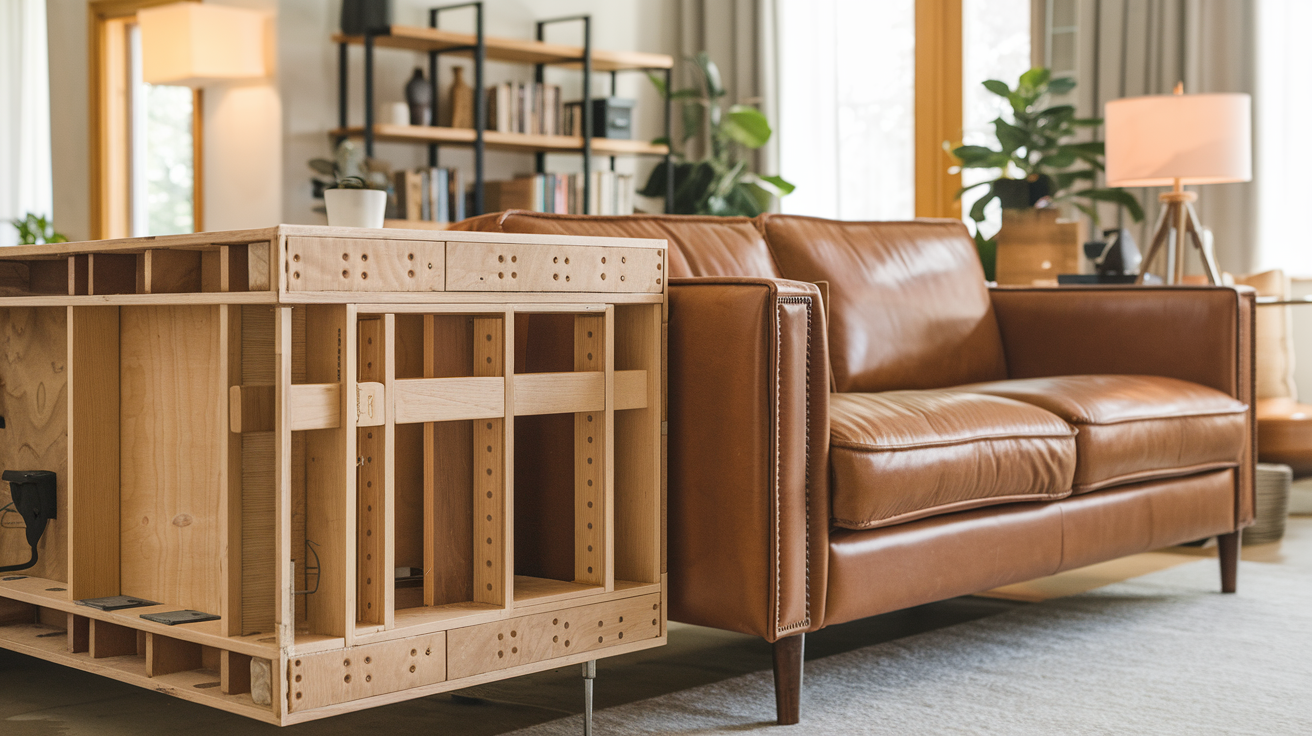
Frame Construction and Durability
Now that we’ve examined how to budget effectively for your sofa purchase, it’s crucial to understand what you’re actually paying for. A significant factor affecting both price and longevity is the frame construction. Even the most beautiful sofa will disappoint if its foundation isn’t built to last.
Solid Wood vs. Alternative Materials
The frame material fundamentally determines your sofa’s durability, comfort, and lifespan. Here’s how the options compare:
Hardwood Frames:
- Made from kiln-dried or treated wood
- Exceptional durability with 20+ year lifespan
- Superior resistance to warping and cracking
- Ideal for heavy-use furniture
- Sustainably harvested, regionally-grown options are best
Softwood Frames:
- Typically pine
- 10-15 year lifespan with proper construction
- Less expensive than hardwood
- More susceptible to warping over time
Metal Frames:
- 30-50% more expensive than wood options
- Excellent stability with 15-20 year lifespan
- Minimal warping concerns
- Modern aesthetic appeal
- Requires adequate cushioning for comfort
- Options include stainless steel and iron
Engineered Wood Options:
- Plywood: Strong and warp-resistant, 10-15 years lifespan
- Particleboard: Budget-friendly but less durable (5-10 years)
- MDF: More affordable but should generally be avoided for frames
Alternative Materials:
- Aluminum: Lightweight and rust-resistant
- Plastic: Used for specific design needs
Signs of Quality Craftsmanship
Beyond the material itself, how a frame is constructed significantly impacts its durability:
Joint Construction:
- Traditional mortise-and-tenon joints offer superior strength
- High-quality frames use wooden dowels, metal screws, and corner blocks
- Beware of frames that rely solely on staples or glue
- Corner blocks provide critical structural reinforcement
Assembly Methods:
- Excessive use of furniture glue often compensates for poor construction
- Quality sofas use low-VOC, water-based adhesives (look for GreenGuard GOLD certification)
- Natural jute webbing enhances frame integrity
- Hand-tied construction techniques indicate premium craftsmanship
Materials Processing:
- Kiln-dried wood is essential to prevent future warping
- This process removes moisture that could cause structural issues later
Evaluating Structural Integrity
When assessing a potential sofa purchase, these practical evaluations can reveal frame quality:
Physical Testing:
- Lift one corner of the sofa—excessive flexing indicates poor frame construction
- Press firmly on arms and backs—creaking or movement suggests structural weakness
- Sit on different sections to check for stability and even support
Suspension Systems:
- Hand-tied, arch suspension systems offer optimal support
- Quality suspension prevents sagging and maintains comfort
- The suspension works with the frame to distribute weight properly
Warranty Coverage:
- Premium manufacturers offer extended frame warranties (sometimes lifetime)
- A long frame warranty indicates manufacturer confidence in construction quality
- Ask specifically about frame coverage in the warranty terms
A well-constructed frame may cost more initially but delivers significant value through extended lifespan and maintained comfort. With your sofa’s structural foundation now covered, we’ll move on to examining upholstery materials and their benefits—after all, the frame provides the support, but the upholstery is what you’ll actually feel and see every day.
Upholstery Materials and Their Benefits
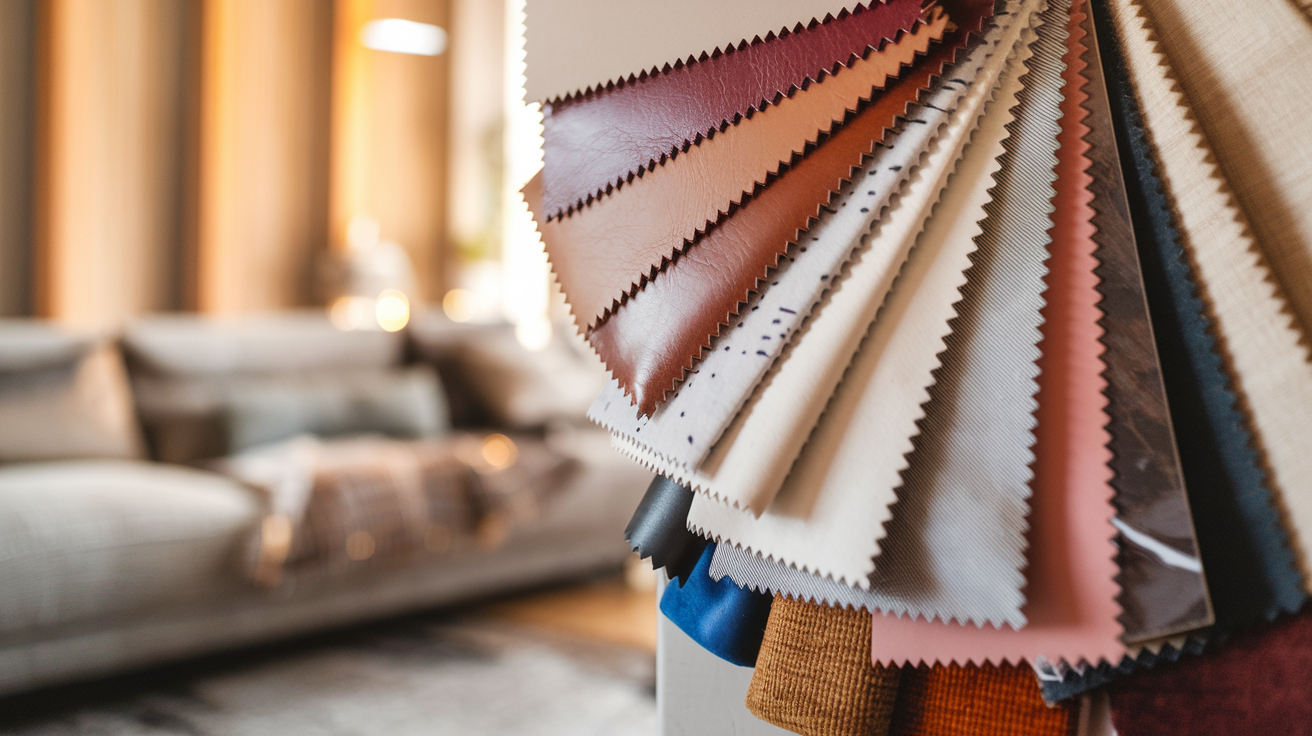
Upholstery Materials and Their Benefits
Now that we have covered the importance of a sturdy frame construction and what makes a durable sofa, let’s explore the various upholstery materials that will dress your furniture. The upholstery is not just about aesthetics—it’s the combination of materials including stuffing, padding, springs, foam, and cushions that contribute to your sofa’s durability, comfort, and longevity. Choosing the right upholstery fabric is crucial, especially considering that reupholstering can be a costly endeavor down the line.
Fabric Options: Cotton, Linen, Wool and Synthetics
Cotton: This natural fiber is celebrated for its breathability, ease of cleaning, and the vast variety of patterns available. Cotton upholstery feels smooth against the skin and is remarkably durable, resisting wear and moisture. It’s particularly suitable for warm climates due to its breathable nature. For optimal performance, look for cotton that has been treated for stain resistance.
Linen: Made from flax fibers, linen offers an eco-friendly option that feels natural and becomes softer with time. It’s a sustainable choice with a distinctive texture that adds character to any space. However, linen may fade when exposed to direct sunlight and tends to wrinkle easily, which can affect its appearance over time.
Wool: This premium natural fiber is known for its durability, stain resistance, and cozy feel. Wool maintains its appearance well even in high-traffic areas, making it an excellent investment despite its higher cost. It’s naturally resistant to pilling and wrinkling, offering both comfort and practicality.
Synthetics:
- Polyester: A budget-friendly option that resists fading and is easy to maintain. While it lacks the breathability and sustainability of natural fibers, polyester is durable and often blended with other materials to enhance performance.
- Nylon: Known for its strength and resistance to stains and UV light, nylon is an excellent choice for busy households. It dries quickly and can withstand heavy use, making it versatile for various applications.
- Microfiber: This synthetic material is soft to the touch and highly resistant to spills, making it perfect for families. However, its tight weave can attract dust and pet hair, requiring regular maintenance.
- Olefin: Stain and water-resistant, olefin is suitable for heavy use but should be kept away from direct sunlight to maintain its integrity.
Leather: Advantages and Maintenance
Leather upholstery offers a classic appeal that transcends trends. Its durability is unmatched—high-quality leather can last decades with proper care. Leather is naturally hypoallergenic, making it an ideal choice for allergy sufferers.
Maintenance is relatively straightforward: regular dusting and occasional conditioning will keep leather looking its best. Unlike some fabrics, leather ages gracefully, developing a patina that adds character over time. It’s also temperature-responsive, feeling cool in summer and warming quickly to body temperature in winter.
While the initial investment is higher than many fabric options, leather’s longevity often makes it cost-effective in the long run. For those concerned about cost or ethical considerations, vegan leather (or faux leather) provides a more affordable alternative, though it may not offer the same longevity or natural feel.
Matching Materials to Your Lifestyle and Needs
The key to selecting the right upholstery material lies in understanding your lifestyle and specific requirements:
For High-Traffic Areas: If your sofa will face daily use from family members, consider durable options like wool, leather, or performance fabrics. For households with children or pets, removable, washable covers in mid-toned colors can be practical.
For Formal Settings: Less frequently used spaces can accommodate more luxurious materials like velvet or linen. Velvet offers elegance and comfort while being resistant to liquids, though it can show dirt readily. Performance velvet variants provide enhanced durability for more active households.
Climate Considerations: In humid environments, cotton may be susceptible to mildew, while leather offers better resistance. For sunny rooms, avoid materials prone to fading like linen and some synthetic options.
Comfort Priorities: If softness is your primary concern, chenille and microfiber provide plush textures, while leather may feel less cozy initially but conforms to the body over time.
When shopping online, request fabric swatches to evaluate textures and colors personally before making a final decision. This hands-on approach ensures your choice aligns with both your aesthetic vision and practical needs.
With the upholstery material selected, we’ll next explore cushion types and comfort factors—elements that will significantly impact how your sofa feels when you sink into it after a long day.
Cushion Types and Comfort Factors
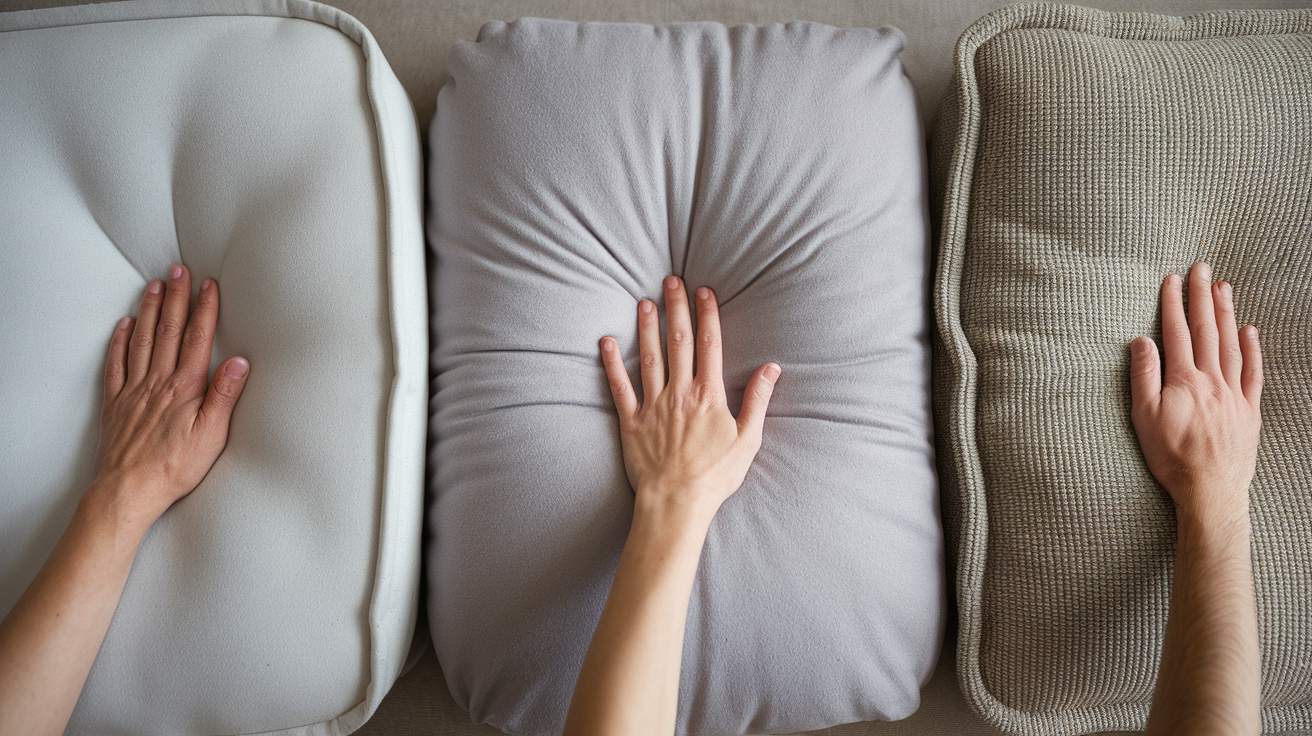
Cushion Types and Comfort Factors
Now that we’ve covered the various upholstery materials and their benefits, it’s time to dive into what truly determines your daily comfort: the cushions of your sofa. While the frame provides structure and upholstery offers aesthetic appeal, cushions are where your body actually makes contact with the furniture, making them crucial to your overall satisfaction.
Fixed vs. Loose Cushions
Your sofa cushion style not only impacts comfort but also contributes significantly to its overall appearance. There are two primary categories to consider:
Fixed Cushions:
- Integral to the sofa’s structure and sewn directly to the frame
- Offer a formal, sleek, and tailored appearance
- Require minimal maintenance as they stay in place
- Ideal for tuxedo-style sofas where a clean line is desired
- Cannot be removed for cleaning or flipping
- Typically provide firmer support due to their construction
Loose Cushions:
- Can be removed from the sofa frame
- Provide a more casual and comfortable experience
- Feature less rigid stuffing, allowing for greater comfort
- Easy to clean and maintain, making them practical for homes with children or pets
- Can be flipped and rotated to distribute wear evenly
- Range from formal to casual in appearance depending on design
The combination of fixed and loose cushions can dramatically influence your sofa’s overall look. For instance, a tuxedo sofa with channel quilting paired with a bench seat creates a seamless, sophisticated effect.
Fill Options: Foam, Down and Blends
The interior of your cushions significantly impacts comfort, support, and longevity. Here are the primary fill options available:
Foam Options:
- Low-density foam: Offers initial softness but compresses quickly and loses shape with regular use
- High-density foam: Provides firmer support that gradually softens over time, with better durability (recommended density around 1.8)
- Memory foam: Conforms to body shape for personalized support, ideal for those with joint pain
- High-resilient (HR) foam: Most durable option, resistant to sagging with excellent spring-back properties
Down and Feather Options:
- Pure down: Extremely luxurious and soft, requiring regular fluffing
- Feather cushions: Provide customizable firmness and a plush feel but may trigger allergies
- Blend down: Combines a thin foam core wrapped in down for softness with better structure
Combination Fills:
- Spring down: Features a coiled spring core surrounded by foam and down layers for both support and softness
- All-foam: Contains multiple layers of different foam types for balanced comfort
- Hollow-fill fiber: Soft cushions ideal for casual lounging and napping, though with less structural support
- Polyester fill: Budget-friendly and hypoallergenic option that may flatten over time
Testing for Personal Comfort and Support
When shopping for the perfect sofa, cushion testing should go beyond a quick sit. Consider these factors:
- Extended testing: Spend at least 5-10 minutes sitting on potential sofas rather than briefly perching
- Position versatility: Test different sitting positions that match how you’ll use the sofa
- Density vs. comfort: Remember that higher density correlates with durability rather than firmness
- Traffic considerations: Choose cushion types based on how frequently the sofa will be used:
- High-traffic areas benefit from durable foam options
- Formal living rooms can accommodate more delicate fills like down
- Personal preference: Prioritize your comfort needs—some prefer firmer support while others enjoy sinking into plush cushions
With a thorough understanding of cushion types and comfort factors, you’re now ready to explore how different sofa styles can match your aesthetic preferences. The cushion type you select will work hand-in-hand with your chosen style to create the perfect centerpiece for your living space.
Sofa Styles to Match Your Aesthetic
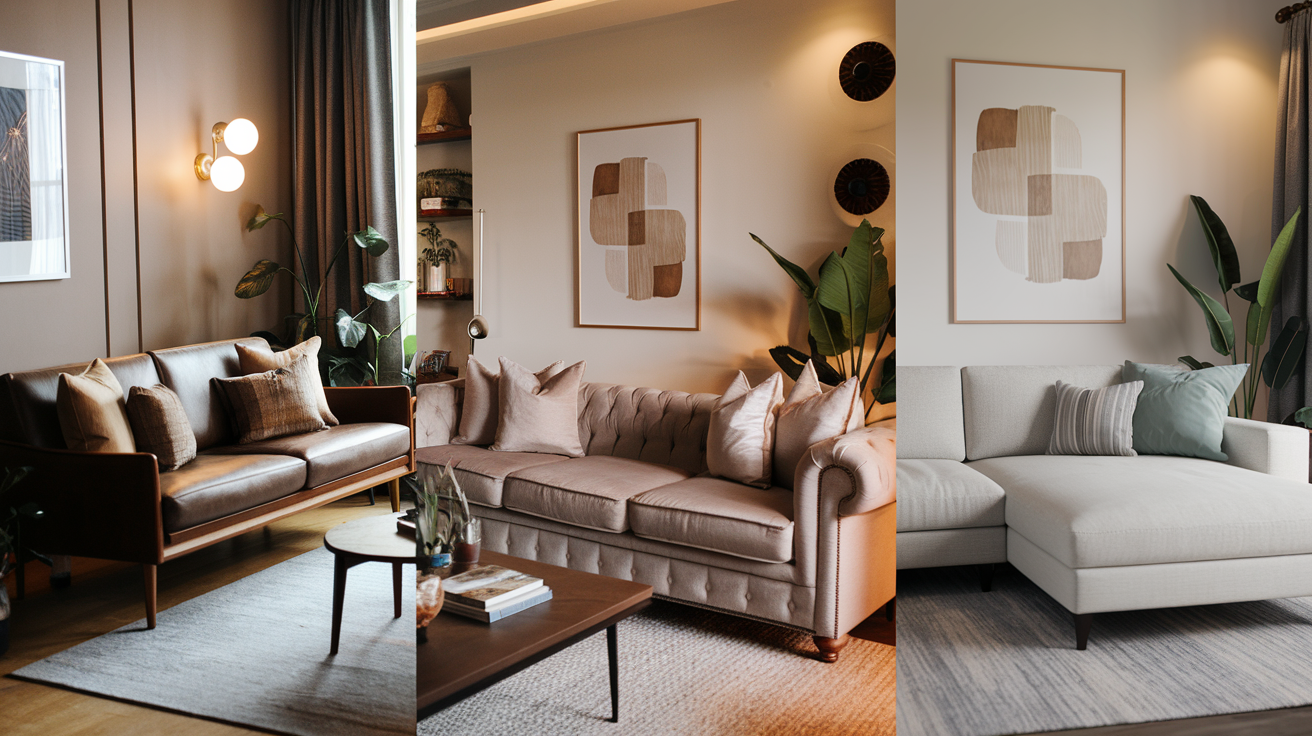
Sofa Styles to Match Your Aesthetic
Now that we’ve explored cushion types and what makes a sofa truly comfortable, it’s time to focus on finding a style that complements your home’s aesthetic. The right sofa style serves as the foundation of your living space, reflecting your personal taste while providing the comfort we previously discussed.
Traditional, Contemporary and Mid-Century Designs
Traditional sofas showcase exceptional craftsmanship with decorative details like rolled arms, deep buttoning, and ornate woodwork. These timeless pieces often feature camelback designs, characterized by their pronounced back hump, or Chesterfield styles with their iconic low rolled backs and deep button tufting. The English Roll Arm sofa, a Victorian favorite, offers a deep seat with a gentle recline, making it both elegant and comfortable.
Contemporary sofas, by contrast, embrace streamlined, uncomplicated designs with hidden frames and modern materials. These pieces prioritize clean lines and minimalist aesthetics, perfect for modern homes seeking simplicity and function. They often feature track arms and tight backs for a sleek profile.
Mid-century modern designs have experienced a significant revival, influencing many current trends. Characterized by tapered legs, clean lines, and organic forms, these sofas balance retro appeal with timeless functionality. The recent resurgence of 1970s-inspired pieces, like the Tactile Sofa by Baxter, combines mid-century elements with modern sensibilities, featuring low profiles and bold patterns that make a statement while remaining functional.
Sectionals, Loveseats and Specialty Options
Sectional sofas remain among the most versatile options, offering adaptable configurations to suit various room layouts. U-shaped sectionals create intimate conversation areas, while L-shaped designs maximize seating in corner spaces. The modular sofa, featuring interchangeable sections, has gained popularity for its flexibility in adapting to changing needs and spaces.
Loveseats provide a compact alternative for intimate spaces or as complementary pieces to larger sofas. These two-seater options maintain the style elements of full-sized sofas while offering versatility for smaller rooms or creating conversation areas.
Specialty options include the innovative dual aspect sofas, which provide space-efficient solutions for open-concept areas by encouraging social interaction from multiple angles. The Camaleonda sofa by Mario Bellini emphasizes modularity with its adaptable design, while pit sofas create sunken, sociable spaces perfect for family gatherings. For unique statement pieces, consider designs like the Bocca (inspired by Salvador Dalí) or the Knole sofa with its distinctive detachable sides that originally served as draft protectors.
Design Elements: Welting, Nailhead Trim and Leg Styles
The details make the difference when selecting a sofa that truly reflects your aesthetic. Contrast trim, including piping (welting) and decorative fringe, adds unique personality to traditional sofa designs. These subtle elements can transform a standard piece into something distinctive that resonates with your personal style.
Nailhead trim offers another decorative option, traditionally seen on Chesterfield and other classic designs. This element provides texture and visual interest while defining the sofa’s silhouette.
Leg styles significantly impact a sofa’s overall appearance. Cabriole legs, with their distinctive S-shape, evoke opulence and traditional elegance. Tapered wooden legs suggest mid-century modern influence, while metal hairpin legs create an airy, contemporary feel. Block legs provide a more substantial, grounded appearance suitable for various styles.
Current trends include fluted designs that add sculptural elements while maintaining a tidy appearance, and innovative features like integrated side tables that streamline living spaces.
With an understanding of the right sofa style for your aesthetic, we’ll next explore color and pattern considerations to further personalize your selection. The current shift toward warm, earthy tones and bold patterns will provide exciting options for expressing your individuality through your sofa choice.
Color and Pattern Considerations

Color and Pattern Considerations
Now that we’ve explored various sofa styles to match your aesthetic preferences, it’s equally important to consider the color and pattern of your new sofa. The right color choice can dramatically impact your space’s overall feel and cohesiveness.
Popular Color Choices and Their Impact
Selecting the perfect sofa color requires thoughtful consideration of your existing space. Several popular options offer distinct benefits:
- Gray: Highly versatile and pairs well with virtually any color scheme
- Green: Creates a sense of luxury and depth in your living space
- Pink: Surprisingly functions as a new neutral in modern design
- Blue: Offers tremendous variety in tone, from light sky blue to rich cobalt
- Cream: Soft and adaptable, working well in various design styles
- Black: Perfect for creating a dramatic aesthetic statement
- Beige: A classic, versatile option that stands the test of time
- Brown: Suits various interior styles while offering practicality
- Navy: Provides a warm and welcoming atmosphere
- Teal: Delivers a bold yet calming presence
- White: Creates a fresh, beachy vibe in your space
Room size should influence your color selection. Interior designers like Rozit Arditi recommend lighter shades for smaller spaces to create an illusion of openness. Conversely, larger rooms can accommodate bolder, more dramatic colors without feeling overwhelming.
Your wall color also plays a crucial role. Neutral walls offer maximum flexibility in sofa color selection, while bold or patterned walls typically pair better with solid-colored sofas that complement the existing palette.
Solid vs. Patterned Upholstery
When deciding between solid colors and patterns, consider both practical and aesthetic factors:
Solid Colors:
- Provide timeless appeal that remains stylish across changing design trends
- Allow for greater flexibility with other decor elements
- Neutral solids (beige, gray, navy, taupe, cream) offer the most versatility
Patterned Upholstery:
- Can serve as a striking statement piece, especially in larger spaces
- Works best when other furnishings remain neutral to maintain balance
- May limit future decor changes as patterns need to coordinate with other elements
For those hesitant about committing to bold patterns or colors, design experts like Rasha Rizwan suggest incorporating trending elements through easily replaceable accessories such as throw pillows and blankets rather than the sofa itself.
Coordinating with Existing Decor
Creating a cohesive look requires careful coordination with your existing decor:
-
Consider your flooring: Dark sofas can blend into dark floors, potentially making the space feel smaller. If you have dark floors but want a dark sofa, choose one with lighter legs or add a contrasting rug underneath.
-
Use your existing color scheme: Incorporating hues already present in your space creates a harmonious look. As designer Rozit Arditi suggests, start with your area rug to guide fabric and color choices.
-
Balance statement pieces: If your sofa makes a bold statement, keep other furnishings neutral to avoid visual competition.
-
Add complementary elements: Use accent pillows and throws that incorporate your sofa color to create visual connections throughout the room.
-
Consider practical factors: Light-colored sofas may show dirt and stains more easily, making washable slipcovers a practical choice for families with children or pets.
With color and pattern decisions made, we’ll next explore functionality and special features that can enhance your sofa’s utility while maintaining its aesthetic appeal. These practical considerations will ensure your sofa not only looks beautiful but also serves your lifestyle needs effectively.
Functionality and Special Features
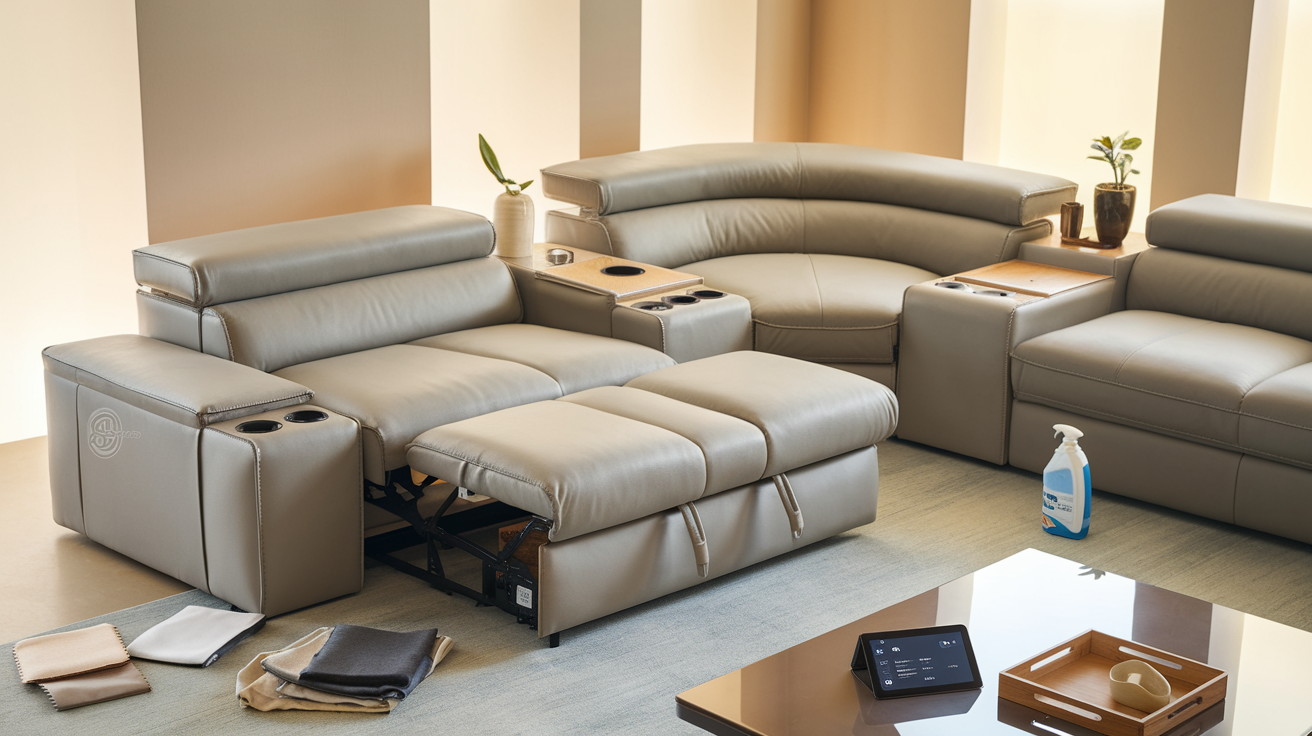
Functionality and Special Features
Now that we’ve explored color and pattern considerations for your sofa, it’s time to dive into the practical aspects that can elevate your furniture from merely decorative to truly functional. Today’s sofas offer far more than just a place to sit—they can transform to meet various needs while maintaining style and comfort.
Multi-Purpose Options: Sofa Beds and Recliners
Modern living often demands furniture that serves multiple purposes, especially in smaller spaces. Convertible options have evolved significantly to offer comfort without compromise:
-
Revolve Sofa Bed: This innovative design earned a RED DOT Award for its simple yet effective 180-degree rotation mechanism that transitions seamlessly between sitting and sleeping positions.
-
Jaxx Zipline Sleeper Sofa: Perfect for homes that occasionally host guests, this versatile piece functions as both a comfortable sofa and a guest bed. It can even double as a children’s play mat, making it ideal for family homes.
-
IULULU Convertible Futon Bed: Features a practical click-clack mechanism allowing for three different positions. The built-in cupholders add convenience for entertaining or relaxing with a beverage.
-
Best Choice Splitback Sleeper: Offers dual reclining functionality, providing customized comfort for two people simultaneously—perfect for couples with different lounging preferences.
Many of these convertible options now include high-density foam cushions that maintain their shape and support whether configured as a sofa or bed, ensuring comfort isn’t sacrificed for functionality.
Modular Designs for Flexibility
Modular sofas provide the ultimate in adaptability, allowing you to reconfigure your seating as your needs change:
-
Keypad Sofa: Designed specifically for public spaces but equally suitable for homes, this adaptable piece allows for multiple seating configurations with minimal effort, accommodating different social situations.
-
Love (Me) Tender: Designer Patricia Urquiola’s creation features an aluminum frame with interchangeable parts, combining aesthetic elegance with practical flexibility.
-
Prado Modular Sofa System: This system allows users to customize backrest positions for optimal comfort, adapting to different activities from conversation to relaxation.
-
Float Sofa and Screen: Beyond seating, this innovative design includes modular elements that can function as room dividers, helping to define spaces in open-plan layouts.
-
Bibik Loft Sofa: Features movable armrests that can be repositioned for various uses and settings, allowing you to transform the sofa’s function throughout the day.
Storage Solutions and Tech Integration
Today’s sofas can help organize your space while keeping you connected:
-
Hidden Storage Compartments: Many modern sectionals, like the Homelegance Sectional Sofa, include discreet storage space within the chaise or under seat cushions—perfect for storing throws, pillows, or remote controls.
-
Charging Capabilities: Some contemporary sofas come equipped with built-in USB and Type-C charging ports, eliminating the need to hunt for outlets when your devices need power.
-
Integrated Convenience Features: Look for sofas with built-in cup holders, like the STENDMAR Sectional Sofa, which combines comfort with practical features for entertainment.
-
Scaffold Sofa: This innovative design functions as both seating and a bookshelf, perfect for small spaces where furniture needs to serve multiple purposes.
-
Sofa Float: Doubles as both a lounging area and workspace with removable backrest cushions and built-in cubbies for storage, ideal for those who work from home.
With these functional features in mind, next we’ll explore how to properly maintain and care for your sofa investment, ensuring that whatever style and features you choose will continue to serve you well for years to come.
Maintenance and Care
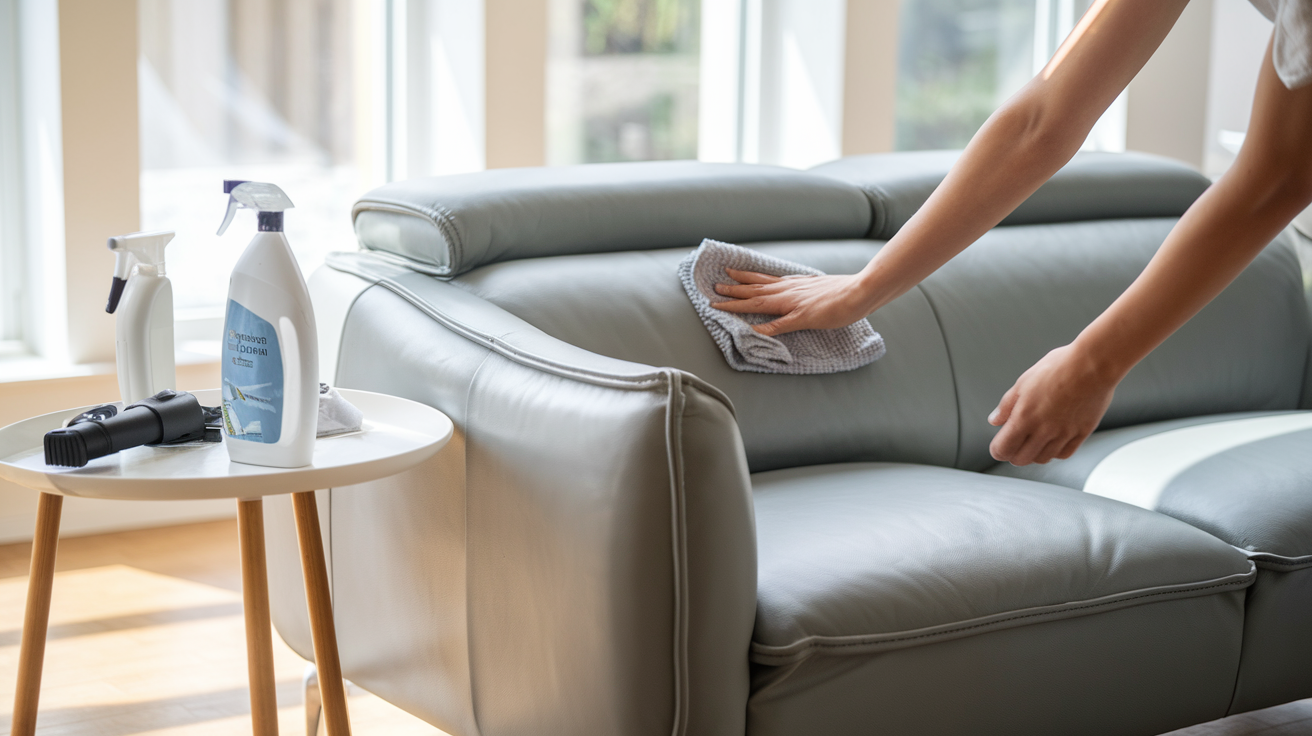
Maintenance and Care
Now that we’ve explored the various functionality and special features that can enhance your sofa experience, it’s equally important to understand how to properly maintain your investment. Proper care not only preserves your sofa’s appearance but also significantly extends its lifespan, ensuring you enjoy comfort and style for years to come.
Cleaning Tips for Different Materials
Different sofa materials require specific cleaning approaches to maintain their quality:
Fabric Upholstery
- Vacuum regularly to remove dust and debris
- Treat stains promptly to prevent setting
- Check the manufacturer’s tag for cleaning codes:
- W: Use water-based cleaners
- S: Use solvent-based cleaners
- W/S: Both water and solvent cleaners are safe
- X: Vacuum or brush only, no liquid cleaning
Leather
- Wipe with a dry cloth weekly
- Apply leather conditioner periodically to prevent drying and cracking
- Avoid harsh chemicals that can damage the finish
Faux Leather
- Clean with a damp cloth as needed
- Simpler maintenance than genuine leather
- No conditioning required
Velvet
- Brush gently in the direction of the nap
- Use specialized cleaning products designed for velvet
- Avoid excessive moisture
Microfiber
- Highly stain-resistant, making it ideal for families
- Vacuum regularly to maintain appearance
- Clean spills immediately with appropriate cleaners
Wooden or Cane Accents
- Dust regularly with a soft cloth
- Apply appropriate wood polish to maintain luster
- Keep away from excessive moisture
Preventative Maintenance Strategies
Taking proactive steps can significantly reduce the need for deep cleaning and repairs:
-
Regular Vacuuming: Weekly vacuuming removes dust and prevents it from settling into fibers.
-
Cushion Rotation: Rotate and flip cushions regularly to ensure even wear.
-
Immediate Spill Treatment: Act quickly when spills occur:
- Blot (don’t rub) with a white absorbent cloth or paper towel
- Apply appropriate cleaning solution based on material type
- Rinse with cold water if suitable for the fabric
- Ensure thorough drying to prevent mold and discoloration
-
Protective Measures:
- Use slipcovers or throws in high-use areas
- Position sofas away from direct sunlight to prevent fading
- Be cautious with lotions or oils that might transfer to fabric
-
Natural Deodorizing:
- Sprinkle baking soda on fabric surfaces, let sit, then vacuum
- This eliminates odors without harsh chemicals
Extending Your Sofa’s Lifespan
Long-term care practices can add years to your sofa’s useful life:
Deep Cleaning Schedule
- Plan for deep cleaning every 6-12 months
- Consider professional cleaning services for delicate materials or stubborn stains
- Professionals utilize advanced techniques that may not be replicable at home
Addressing Common Issues
- Sagging Cushions: Add additional padding or replace foam when necessary
- Loose Legs: Tighten regularly to maintain structural integrity
- Fabric Tears: Address small tears immediately before they expand
- Leather Repairs: Use appropriate patching methods for small cracks or tears
Maintenance Tools
Essential tools for sofa care include:
- Vacuum cleaner with upholstery attachments
- White absorbent cloths for blotting spills
- Spray bottle for cleaning solutions
- Horse-hair brush for delicate fabrics
- Appropriate cleaning agents for your specific material
Remember that using household cleaners inappropriately can damage your sofa. Always check compatibility with your sofa’s material before applying any product, and when in doubt about cleaning vintage or delicate pieces, consult professional cleaners for advice.
By following these maintenance guidelines, your sofa will remain a beautiful and comfortable centerpiece in your home for many years, providing the best possible return on your investment.
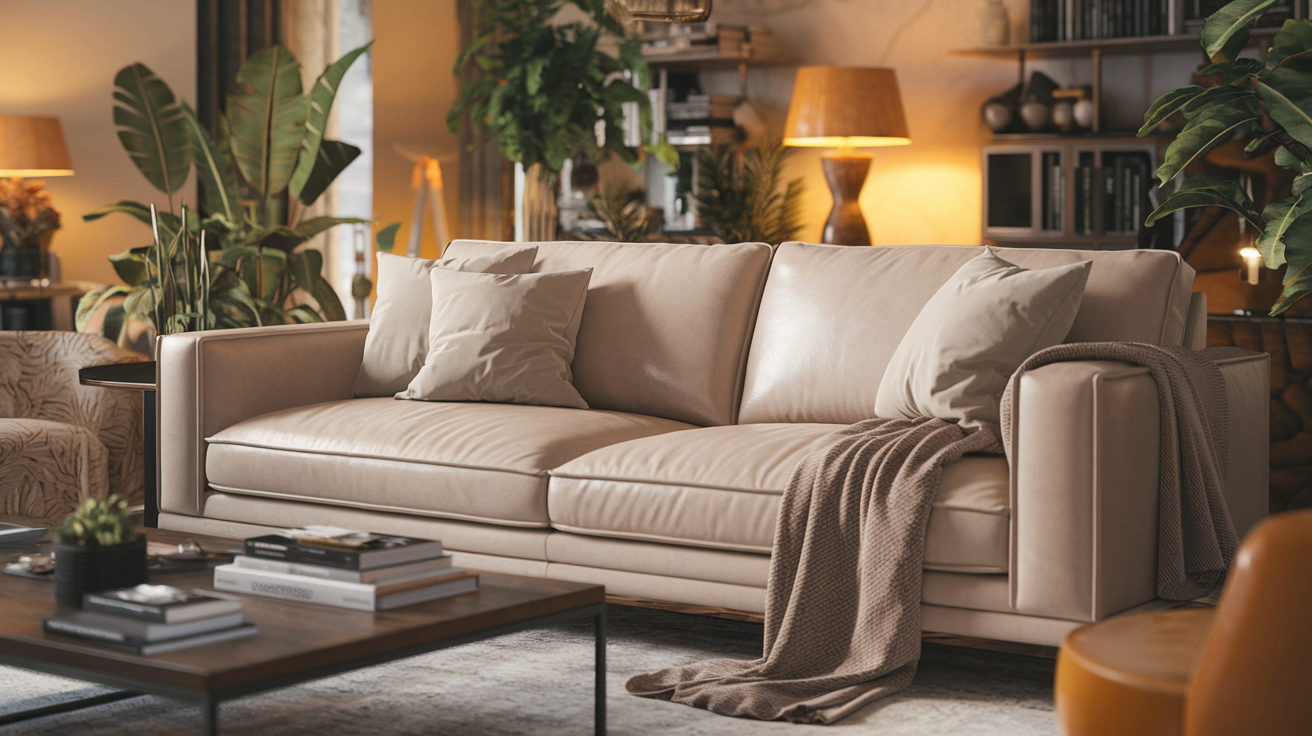
Choosing the perfect sofa is a significant investment that impacts both your home’s aesthetics and your daily comfort. By carefully considering dimensions, budget, frame construction, upholstery materials, cushion types, style preferences, color choices, functionality, and maintenance requirements, you’ll ensure your selection stands the test of time. Remember that the ideal sofa balances visual appeal with practical features that suit your specific lifestyle needs.
Before making your final decision, take time to test your potential sofa for comfort, understand warranty details, and accurately measure your space—following the “Measure Twice, Buy Once” principle. Whether you’re drawn to the elegance of a tufted design, the versatility of a sectional, or the practicality of a sofa bed, your perfect sofa awaits. Trust your personal style while keeping functionality at the forefront, and you’ll create a living space that’s both beautiful and livable for years to come.
The Ultimate Guide to Choosing the Perfect Sofa: Style, Comfort
